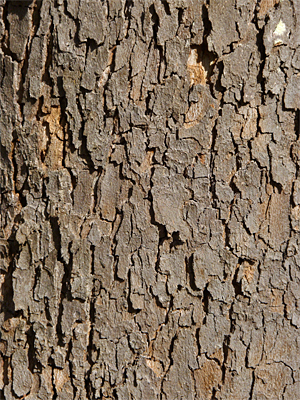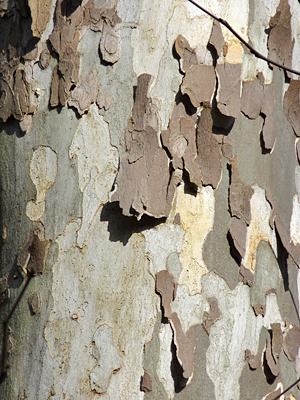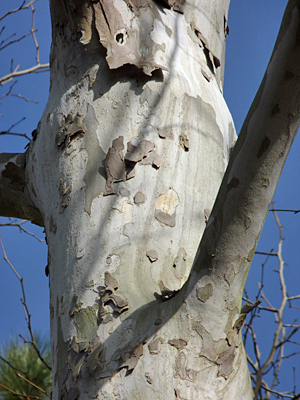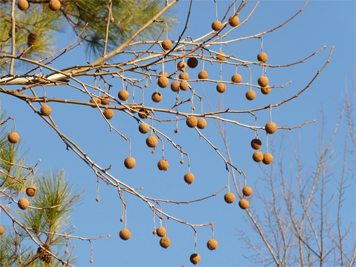
I was recently asked whether or not I knew why the bark on American Sycamore drops off the tree in large thin flakes. Coincidentally, while walking around the Outdoor Exhibits this winter with camera in hand, I’ve been taking photos of various trees to use on this blog in a series of informal, mini-field guides. My intention was to start with some of the more readily identifiable winter trees, trees without leaves. Although winter’s nearly over, this is a good time to squeeze in at least one of those mini-guides.
One of the easiest of trees to identify is the American Sycamore. It’s white upper bark standing off against the winter sky, and other trees in the forest, make it hard to miss and appreciate.
Sycamore is a tree of the bottomlands. Just about any stream or river in our area has it’s share of sycamores growing along its banks, often alongside River Birch. Here at the Museum it grows next to the Wetlands as well as in the swamp between Catch the Wind and Explore the Wild. This handsome tree is often planted along city streets but its roots are near the water.
Many trees have a different type of bark at the base of the trunk than they do at the younger, upper portion of the tree. The sycamore takes this to the extreme.
Take a look at the tree on the right. Scroll up and follow the bark up to the top. It starts out as “typical” gray bark. As you scroll up you’ll notice that the darker bark begins to flake off until finally it becomes nearly all white at the top of the tree.
Towards the middle of the three, starting at about a quarter to a third-way up the tree, the bark often appears “camouflaged” with various gray, brown, and green hues.
Below are some close-ups of the bark.



But, why do sycamores shed their bark? Why does the bark peel off in large thin flakes all season long? I’ve sometimes wondered that myself, but apparently not long or hard enough to actually find out…until now.
Trees have bark to help protect them from losing moisture and drying out, protect themselves from insects (although there are many insects that get past this defense), birds (woodpeckers go in after the insects), and disease. And, all trees have bark specific to the trees themselves. Flowering Dogwood has scaly “alligator” bark. Loblolly Pine has furrowed, segmented bark which bares a resemblance to the loblollies on a dried lake bed. Shagbark Hickory has a shaggy appearance with big, gray pieces of bark sticking out from the trunk. Sycamore has bark that peels off and becomes white near the upper portion of the tree.
What evolutionary advantage is it for a tree to shed it’s bark the way sycamores do? Everything from the tree’s favored habitat to photosynthesis has been suggested by people who should know, people who study trees. Most of the theories that I’ve read seem like sound reasons for this bark shedding habit. Apparently though, there is no definitive answer to the question of why this tree looks and behaves the way it does.
Instead of me quoting or paraphrasing the various suggested answers to this question, from another source, it may be easier for you to read them yourself. The linked article is from the Daily Plant out of NYC, NY and tries to answer the question of why sycamore sheds its bark through an interview with Dr. Marc Abrams, Professor of Forest Ecology at Penn State University.
Oh yeah, back to the identification of the tree. If the bark doesn’t nail down the ID of this tree for you, perhaps the many fruit balls that typically dangle from the branches will do it.

The fruit hang from the tree throughout the winter, are about an inch to an inch and a quarter in diameter and, unlike the spiky seed balls of Sweetgum, are soft to the touch.
On your next walk through Explore the Wild stop at the platform midway down the boardwalk. If you stand facing the Animal Footprints Exhibit and look about 40 degrees or so to your left you’ll see an excellent example of an American Sycamore with all of the features described above. Another is about the same amount of degrees to your right. If you look about 90 degrees to your right you’ll see a slim, straight sycamore which is nearly all green, all the way to the crown. Why is this sycamore green and not white? That one will have to wait for another day, maybe.
Enjoy your walk.
How can I stop my tree to stop peeling?
We have two very mature and humoungous American Sycamore trees, any idea why one produces tons of seed balls, while the other produces none at all? Male vs. female?
No, they’re monoecious, both male and female flowers on same tree.
Does one tree of your trees consistently produce fruit and not the other, or is it one this year and the other the next? Or perhaps a two year cycle?
Perhaps there are male and female trees.
at what age will the bark of a sycamore start to turn white. The trees I have are young and have green bark along with brown.
I’m not sure I know the answer to the question of at what age the sycamores turn white. I’ve seen trees of apparently the same age, certainly the same size, one of which has white upper branches and trunk while the other has green upper branches and trunk, those trees only thirty some feet of one another.
I can say, with some certainty, that the upper branches and trunk will begin to whiten once the main trunk near the base reaches a diameter of about 12 – 15 inches.
The tree neax door looks like it’s splitting has what looks like a Crack running down it is this normal
It’s hard to say what’s going on with the tree without seeing the tree itself. Can you send a picture to, gregd@ncmls.org
Thanks,
I live in Amberon, PA. Surrounded by mountains and creeks. There are many trees here dying. They are by water, and are turning all while, it seems from top to bottom. They are all different types of trees, they are Not birch or Sycamore trees. Do you know what is wrong with these trees?
Can you send a photo or two of the trees? Are the deciduous?
I see on the map that you’re in between the ridges west of Harrisburg, any nat gas drilling going on nearby?
Send images.
how do I send you pictures of the white trees?
Send them attached to this email address:
gregd@ncmls.org
Thanks,
My to sons planted one each on Arbor day over 20 years ago as little saplings and now they are about 50+ tall. Out of all these years I have never seen it shed this much at one time. We had a storm with straight line winds up to 90 mph about six weeks ago and lost some big limbs in the process along with having to cut some off with a chainsaw which I would think it would cause a growing spret. My question is could a sudden spert in growth cause shedding , kind of like buying a 10 year old clothes and they out grow them as fast as you can buy them?
I don’t really know whether or not a quick spurt in growth could cause more shedding, but in theory it sounds good.
Thanks,
I was driving through a section of Rouge Park in Detroit and noticed a group of white trees with patchy, scaling bark. Thanks for your in depth explanation.
Glad to have helped.
I never thought about the trunk of a large, mature sycamore continuing to grow when I had a tree house built around mine in 2008. Now the tree has filled the gap in the flooring and has popped some of the smaller boards loose. Is there any chance that other areas will grow around the framing, like in the roof, or is my tree house doomed?
Not being able to see your tree house I can’t tell what may happen to it, but yeah, the tree will continue to grow as long as it’s alive. There is more of a height limit than there is a girth limit, the trunk keeps getting wider, hence the rings inside the trunk. There’s a tree near Waynesville, NC that is “132 feet tall and 268 inches wide” (probably means 268 inches in circumference), which is about 22.3 feet in circumference. There’s a stump of a dead sycamore in Indiana that was/is 57 feet in circumference when a storm split the trunk and knocked it over.
Good luck!
Thanks for the info–tried several sites to identify but mostly leaf ID’S. I’m a “recycler” of trees, i.e., in my fireplace or neighbors with woodstoves and the ash goes to my compost. Have several downed A.S. in my area and wanted to know if hardwood before I “light up?” How hard is A.S.??
I’ve never burned sycamore but a quick search revealed that it is “OK” to burn, not the best but it will produce a moderate amount of heat. Make sure that you season it, let it dry out. I would think that if you’re cutting it now it probably won’t be ready before next winter.
Good luck,
Thanks for the info!! Your site’s the best.
We have dozens of these trees in my neighborhood, and I couldn’t figure out if they were diseased or what was the reason for them shedding their bark. I couldn’t identify them either except that they were white where the bark was gone. Thanks for clearing up this mystery for me.
My pleasure, Elizabeth.
Although these trees are associated with wet areas they have been planted extensively along streets and avenues across the country. How many towns and cities have a Sycamore Avenue, Lane, or Street?
Thanks,
I hate those trees, they are beautiful when they are white, but they make a mess all year long and their leaves make so much dust when raking them.
Thanks for the post!! Very informative, if not totally conclusive. I was looking at the sycamores again yesterday and noticed that, along with their fruit balls, there were what looked like some little balls of fluff hanging from the branches. I guess the seeds are about ready to disperse? Has the warmer weather awakened them?
That’s right, the seeds are ready to disperse. The balls break apart and the seeds are cast to the wind. In fact, with the steady SW winds today (Wednesday, 3/10) I saw many of the seeds floating by me like little paratroopers as I stood on the boardwalk and elsewhere in Explore the Wild and Catch the Wind.
We have a tree like that in our yard and we never knew what kind of a tree it was. Know we know…